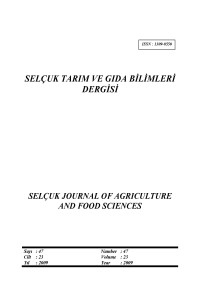The Effects of Different Pollen Trap Types Anddifferent Trapping Periods on The Performance of Honey Bee (Apis mellifera L.) Colonies
Öz
This study was carried out to determine the effects of using two different polen traps for different periods in honey bee colonies on brood production, bee population, pollen and honey production. The experimental groups were set up as follows: Group I was pastoral trapped for 3 days at 3-day interval, Group II was drawer trapped for 3 days at 3-day interval, Group III was pastoral trapped for 6 days at 6-day interval, Group IV was drawer trapped for 6 days at 6-day interval and Group V (the control group) was untrapped. The results showed that the groups had average numbers of frames of bees as 11.3±0.37, 12.0±0.29, 10.9±0.22, 11.5±0.20 and 12.9±0.31 frames/colony; average brood areas as 4680.0±130.3, 5417.7±276.6, 4740.8±93.6, 5405.9±156.5 and 6469.0±246.7 cm2/colony; average honey production as 10.3±0.36, 11.5±1.75, 8.4±0.58, 10.0±0.69 and 16.3±2.19 kg/colony and total pollen production as 392.8±93.50, 1082.5±108.20, 366.6±32.05 and 889.5±99.10 g/colony, respectively. The effects of trap types on the number of frames with bees and on the amount of honey production were found nonsignificant while the effects on brood areas and pollen production were found significant (P<0.05). The effects of periods on the number of frames with bees, brood areas and honey production were found nonsignificant while its effect on pollen production was found significant (P<0.05). Trap x period interaction was found significant (P<0.05) for all traits.
Anahtar Kelimeler
Bal Arısı (Apis mellifera L.) Kolonilerinde Farklı Polen Tuzağı Tiplerinin ve Farklı Sürelerde Tuzak Kullanımının Performans Üzerine Etkileri
Öz
Bu çalışma, bal arısı kolonilerinde iki farklı sürede iki farklı polen tuzağı kullanımının yavru üretimine, ergin arı po-pulasyonuna, polen verimine ve bal verimine etkisini belirlemek amacıyla yapılmıştır. Koloniler; 3 gün arayla 3 gün süreli pastoral tip tuzaklı I. grup, 3 gün arayla 3 gün süreli çekmeceli tip tuzaklı II. grup, 6 gün arayla 6 gün süreli pastoral tip tuzaklı III. grup, 6 gün arayla 6 gün süreli çekmeceli tip tuzaklı IV. grup ve tuzak takılmayan V. grup şeklin-de düzenlenmiştir. Araştırma sonunda ortalama arılı çerçeve sayıları gruplarda sırasıyla 11.3±0.37, 12.0±0.29, 10.9±0.22, 11.5±0.20 ve 12.9±0.31 adet/koloni; ortalama yavrulu alan gruplarda sırasıyla 4680.0±130.3, 5417.7±276.6, 4740.8±93.6, 5405.9±156.5 ve 6469.0±246.7 cm2/koloni; ortalama bal verimi gruplarda sırasıyla 10.3±0.36, 11.5±1.75, 8.4±0.58, 10.0±0.69 ve 16.3±2.19 kg/koloni ve toplam polen verimi gruplarda sırasıyla 392.8±93.50, 1082.5±108.20, 366.6±32.05 ve 889.5±99.10 g/koloni olarak belirlenmiştir. Tuzak tipinin arılı çerçeve sayısı ve bal verimi üzerine etkisi önemsiz; yavrulu alan ve polen verimine etkisi önemli (P<0.05) bulunmuştur. Sürenin arılı çerçeve sayısı, yavrulu alan ve bal verimine etkisi önemsiz bulunmuş, polen verimine etkisi ise önemli (P<0.05) bulunmuştur. Tuzak x süre interaksiyonun ele alınan tüm özelliklere etkisi önemli (P<0.05) bulunmuştur.
Anahtar Kelimeler
Ayrıntılar
| Birincil Dil | İngilizce |
|---|---|
| Konular | Hayvansal Üretim (Diğer) |
| Bölüm | Araştırma Makalesi |
| Yazarlar | |
| Yayımlanma Tarihi | 25 Nisan 2009 |
| Gönderilme Tarihi | 1 Ocak 2009 |
| Yayımlandığı Sayı | Yıl 2009 Cilt: 23 Sayı: 47 |
Selcuk Journal of Agriculture and Food Sciences Creative Commons Atıf-GayriTicari 4.0 Uluslararası Lisansı (CC BY NC) ile lisanslanmıştır.


